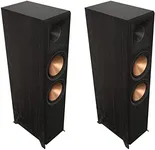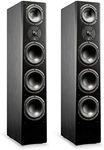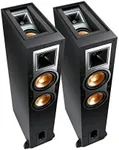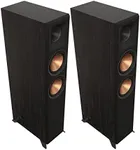Buying Guide for the Best Tower Speakers
When it comes to picking the right tower speakers, it's important to consider several key specifications to ensure you get the best sound quality and performance for your needs. Tower speakers, also known as floor-standing speakers, are designed to deliver powerful, full-range audio and are ideal for home theater systems or high-fidelity music listening. Understanding the key specs will help you make an informed decision and find the perfect speakers for your space and listening preferences.Frequency ResponseFrequency response refers to the range of sound frequencies a speaker can reproduce, typically measured in Hertz (Hz). This spec is important because it indicates how well the speaker can handle both low (bass) and high (treble) sounds. A wider frequency response range means the speaker can produce a more complete and accurate sound. For example, a range of 20Hz to 20kHz is considered excellent as it covers the full spectrum of human hearing. If you enjoy a lot of bass-heavy music or action-packed movies, look for speakers with a good low-end response (below 50Hz). For general music listening, a range that covers 40Hz to 20kHz should suffice.
SensitivitySensitivity measures how efficiently a speaker converts power into sound, expressed in decibels (dB). This spec is important because it affects how loud the speaker can get with a given amount of power. Higher sensitivity means the speaker can produce more volume with less power. Sensitivity ratings typically range from 85dB to 100dB. If you have a lower-powered amplifier or receiver, look for speakers with higher sensitivity (90dB or above) to ensure you get adequate volume without distortion. For larger rooms or louder listening levels, higher sensitivity is beneficial.
ImpedanceImpedance is the resistance a speaker offers to the electrical current from the amplifier, measured in ohms. This spec is important because it affects the compatibility between your speakers and amplifier. Most tower speakers have an impedance of 4, 6, or 8 ohms. Lower impedance (4 ohms) can draw more power from the amplifier, which can be beneficial for louder sound but may require a more robust amplifier. Higher impedance (8 ohms) is easier on the amplifier and is generally more compatible with a wider range of amplifiers and receivers. Check your amplifier's specifications to ensure it can handle the impedance of the speakers you choose.
Power HandlingPower handling indicates the amount of power a speaker can handle from an amplifier without being damaged, measured in watts (W). This spec is important because it ensures your speakers can handle the power output of your amplifier. Power handling is usually given as RMS (continuous power) and peak (maximum power). For example, a speaker rated at 100W RMS and 200W peak can handle 100 watts of continuous power and 200 watts of short-term power. Match the power handling of the speakers to the power output of your amplifier to avoid damaging the speakers. If you have a high-powered amplifier, look for speakers with higher power handling capabilities.
Driver ConfigurationDriver configuration refers to the arrangement and types of drivers (woofers, midrange, and tweeters) in the speaker. This spec is important because it affects the overall sound quality and performance. A typical tower speaker may have multiple drivers to handle different frequency ranges: woofers for bass, midrange drivers for vocals and instruments, and tweeters for high frequencies. More drivers generally mean better sound separation and clarity. If you want a well-balanced sound for all types of music and movies, look for speakers with a three-way configuration (separate drivers for bass, midrange, and treble). For general use, a two-way configuration (woofer and tweeter) can also provide good sound quality.
Cabinet DesignCabinet design refers to the construction and materials used for the speaker enclosure. This spec is important because it affects the speaker's sound quality and durability. A well-designed cabinet minimizes vibrations and resonance, resulting in clearer sound. Look for cabinets made from high-quality materials like MDF (medium-density fiberboard) or solid wood, which provide better acoustic properties. Additionally, consider the size and shape of the cabinet, as larger cabinets can produce deeper bass but may take up more space. Choose a cabinet design that fits your room's aesthetics and space while providing the sound quality you desire.






















